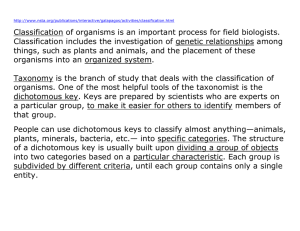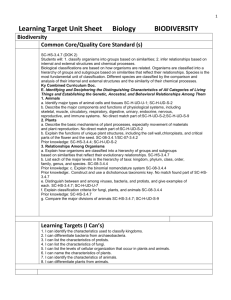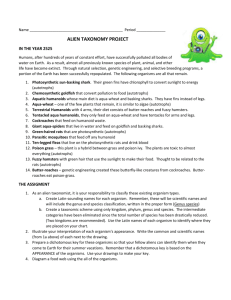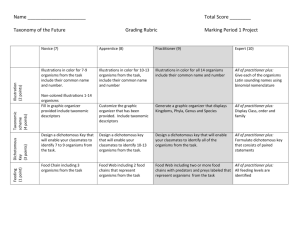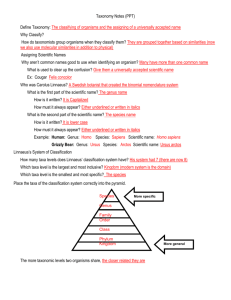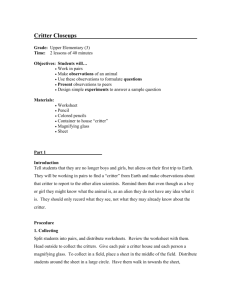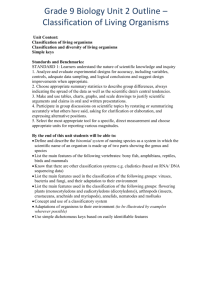WATERS Mini Lesson
advertisement
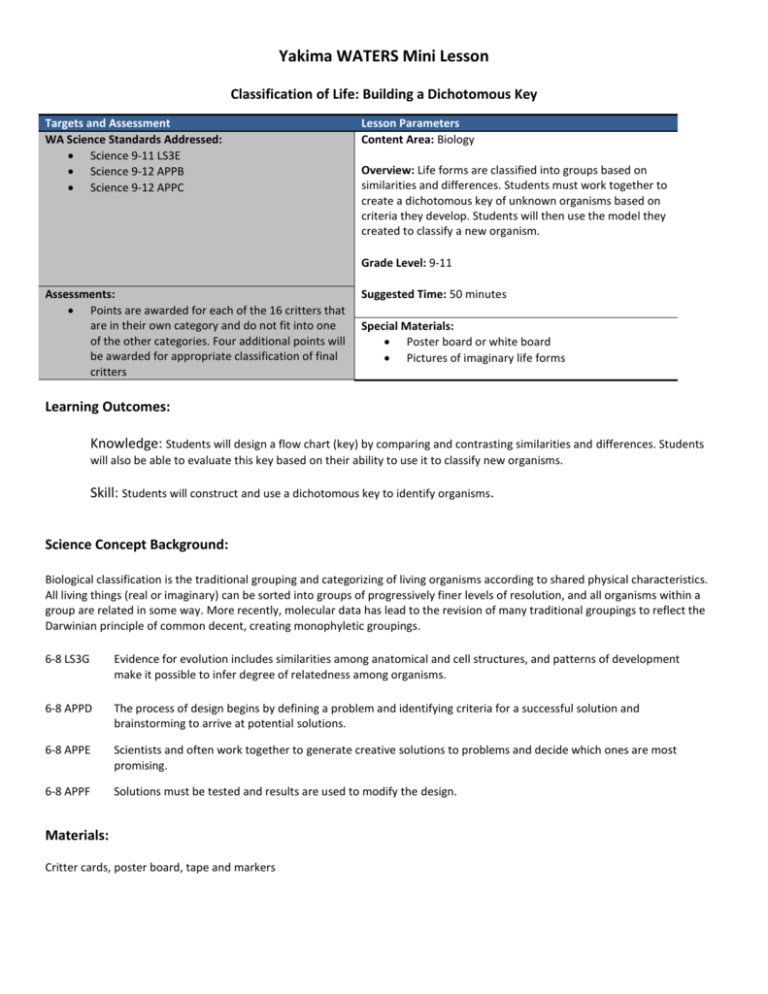
Yakima WATERS Mini Lesson Classification of Life: Building a Dichotomous Key Targets and Assessment WA Science Standards Addressed: Science 9-11 LS3E Science 9-12 APPB Science 9-12 APPC Lesson Parameters Content Area: Biology Overview: Life forms are classified into groups based on similarities and differences. Students must work together to create a dichotomous key of unknown organisms based on criteria they develop. Students will then use the model they created to classify a new organism. Grade Level: 9-11 Assessments: Points are awarded for each of the 16 critters that are in their own category and do not fit into one of the other categories. Four additional points will be awarded for appropriate classification of final critters Suggested Time: 50 minutes Special Materials: Poster board or white board Pictures of imaginary life forms Learning Outcomes: Knowledge: Students will design a flow chart (key) by comparing and contrasting similarities and differences. Students will also be able to evaluate this key based on their ability to use it to classify new organisms. Skill: Students will construct and use a dichotomous key to identify organisms. Science Concept Background: Biological classification is the traditional grouping and categorizing of living organisms according to shared physical characteristics. All living things (real or imaginary) can be sorted into groups of progressively finer levels of resolution, and all organisms within a group are related in some way. More recently, molecular data has lead to the revision of many traditional groupings to reflect the Darwinian principle of common decent, creating monophyletic groupings. 6-8 LS3G Evidence for evolution includes similarities among anatomical and cell structures, and patterns of development make it possible to infer degree of relatedness among organisms. 6-8 APPD The process of design begins by defining a problem and identifying criteria for a successful solution and brainstorming to arrive at potential solutions. 6-8 APPE Scientists and often work together to generate creative solutions to problems and decide which ones are most promising. 6-8 APPF Solutions must be tested and results are used to modify the design. Materials: Critter cards, poster board, tape and markers Procedure: Ask students why it is important for scientists to classify organisms (understand evolution, communicate with other scientists about a group of animals, etc.). Tell them that they will be classifying organisms into groups, based on similarities, to create a dichotomous key. Break the class into groups of 3-4 and give each group 16 randomly chosen critter cards from the 20. Tell the students that they have a sample of alien creatures, which they are going to separate out into groups by comparing similarities and differences between them. Ask students if there is a way to split the entire collection into just two groups (possibilities include characteristics such as eyes, bristles, antennae etc but there is no one correct answer as long as all cards fit into one category or the other). Then, have the students physically separate their cards into those groups at the top of the paper and write the classifying terms below each group. Now, starting with one of the two groups, ask students to separate the critters in that group by making up two new categories. When they have decided on categories, slide those objects to the right, and write the new categories below the new groups. Connect each new group to the original grouping with lines. Repeat this process with the other grouping and continue with each new group until all groups consists of only one critter. The resulting tree is a dichotomous key. Provide each group with the final four critter cards and have them classify these new critters based on their key and defining characteristics. Go around to each group and make sure that they have correctly followed their key to identify the new critter, asking them what features they used and why. Key questions: What characteristics can be used to group similar objects and organisms? How can these characteristic be used to create a dichotomous key? How can a dichotomous key be used to identify an unknown object or organism? Extension(s): Have students use a real dichotomous key to identify subgroups within a larger group (several genus within a family, several species with a genus), identifying the differences between members of the subgroup. Most field guides describe characteristics of different species within a genus. Teaching Tips: You will find that some students will tend to lump while others will be born splitters. Allow students to resolve their own disputes on divisions and indentified criteria. If time allows, have each group swap keys with another group and see if they can categorize their four final critter cards with this new key. Supplements: Microbe World: American Society for Microbiology. Experiments page. Retrieved November 12, 2009 from http://www.microbeworld.org/index.php?option=com_content&view=article&id=344&Itemid=212 Author: Michelle Lester, Yakima WATERS Project, CWU, Fall 2009
